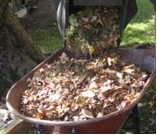By Dawn Pettinelli – Extension Instructor Plant Science & Landscape Architecture
Did you know that almost 25 percent of a typical household’s waste can be recycled right in the backyard? Recycling reduces the amount of solid waste being trucked and dumped into landfills, and the end product of this process, compost, is beneficial to the soil. Compost is the dark, crumbly, earthy-smelling by-product of decomposed plant and/or animal materials. Soil microorganisms transform these organic materials into their original elemental components to be reused by successive generations of plants and other life forms.
Recycle Your Waste & Improve Your Soil
Here’s the basics..what to compost, what not to compost, how to turn the compost, check temperature, and when it’s ready to use.
- What can you compost?
- Materials include leaves, grass clippings, fruit and vegetable wastes, spent garden plants, coffee grounds, eggshells, cardboard and livestock manure.
- Avoid adding meat products, fats, dog or cat droppings, and items that could attract pests, decompose slowly, or contain harmful organisms.
- What should you make your compost in?
Fancy bins, drums, and turning units are available but not essential. Compost piles do not need to be contained but piles look neater and animals are kept out. Build them on any flat site that allows for a 4 cubic foot pile. Cinder blocks, pallets, or fencing can be used to enclose the pile. - Where should you locate your compost pile?
Choose a partially shaded site, close to a source of water and not too far from the house. - Recipe for success
Choose a compost recipe that uses the materials you have. For a fast acting, hot compost it is best to add all the ingredients at once, building a pile 3 to 4 feet high and wide. Vary the materials used and chop them so there is more surface area exposed. Add water to make piles slightly moist. Adding organic materials in layers gives a feel for the proportions used. A shovelful of soil or finished compost is added to inoculate the pile with microorganisms. Avoid adding limestone or wood ashes. - What is the carbon (c) to nitrogen (n) ratio and why is it important?
Soil microbes need carbon from brown, woody materials for energy, and nitrogen from green, vegetative matter for food. The amount of carbon in a compost pile relative to the amount of nitrogen is the carbon to nitrogen (c:n) ratio. Decomposition occurs most rapidly when the c:n ratio is about 25:1. This is achieved by using one-third green to two-thirds brown materials. - When should compost piles be turned?
Turn compost piles at least once a month. If making a hot compost pile, then it should heat up to 140°F in a few days and should be turned each time the pile temperature decreases to about 100°F. - When is the compost ready?
Depending on the organic materials used and pile maintenance, compost is ready to use in as little as one month or up to a year. Compost is finished when the original materials are no longer recognizable and it is earthy smelling, dark, and crumbly. - What can you do with your compost?
Compost can be incorporated into the soil before planting, used to topdress lawns and gardens, or added to homemade potting mixes. Keep in mind that the nutrient content of compost varies with the ingredients. Periodic soil testing will monitor the soil’s nutrient levels.